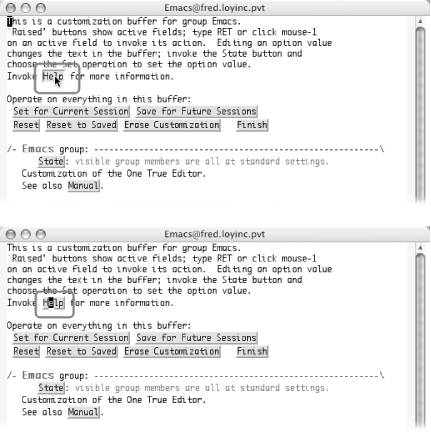Книга: Learning GNU Emacs, 3rd Edition
10.1.1 Navigating Custom
10.1.1 Navigating Custom
You can move around in a given Custom screen much the way you do in any other part of Emacs. All of the basic cursor movement commands like C-n and C-p work just as they should. But that's only part of the story in Custom. To accomplish anything useful, you need to activate special words and phrases. Those bits of text in grey boxes that look like buttons are the words and phrases in question.
To activate one of these buttons, click on the button with the mouse or position your cursor inside its borders and press Enter. Figure 10-1 highlights these options.
Figure 10-1. Custom button activation using the mouse cursor (top) and the keyboard cursor (bottom) (Mac OS X)

When you finish looking at a screen, if you are not interested in changing anything, you can type C-x k to kill the current buffer and go back to the previous screen. You can also activate the Finish button in the common header set discussed next.
- 4.6.2 Navigating Windows
- 14.4 Navigating Emacs Documentation
- Navigating Through the File System
- 4.3.5. Custom Configuration Options
- 6.2.3. Customized Initial Process
- 16.2. Custom Linux for Your Board
- 16.2.2. Customizing Kernel Initialization
- 10.3.3 Customizing Fonts Through Custom
- Navigating networking in Windows Server 2012 R2
- Creating Custom Exceptions
- Google Custom Search Engine
- 10.7 Starting Modes via Auto-Mode Customization




